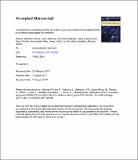Por favor, use este identificador para citar o enlazar a este item:
http://hdl.handle.net/10261/156889COMPARTIR / EXPORTAR:
 SHARE SHARE
 CORE
BASE CORE
BASE
|
|
| Visualizar otros formatos: MARC | Dublin Core | RDF | ORE | MODS | METS | DIDL | DATACITE | |

| Campo DC | Valor | Lengua/Idioma |
|---|---|---|
| dc.contributor.author | Sánchez Torres, Paloma | es_ES |
| dc.contributor.author | Vilanova, Laura | es_ES |
| dc.contributor.author | Ballester Frutos, Ana Rosa | es_ES |
| dc.contributor.author | López Pérez, Mario | es_ES |
| dc.contributor.author | Teixidó, Neus | es_ES |
| dc.contributor.author | Viñas, Inmaculada | es_ES |
| dc.contributor.author | Usall, Josep | es_ES |
| dc.contributor.author | González-Candelas, Luis | es_ES |
| dc.contributor.author | Torres, Rosario | es_ES |
| dc.date.accessioned | 2017-10-30T12:02:42Z | - |
| dc.date.available | 2017-10-30T12:02:42Z | - |
| dc.date.issued | 2017-08-12 | - |
| dc.identifier.citation | Food Microbiology 69: 123-135 (2018) | es_ES |
| dc.identifier.issn | 0740-0020 | - |
| dc.identifier.uri | http://hdl.handle.net/10261/156889 | - |
| dc.description.abstract | Blue mould disease caused by Penicillium expansum infection is one of the most important diseases of pome fruit accounting for important economic losses. In the present study, the PeSte12 transcription factor gene was identified, and deletant mutants were produced by gene replacement. Knockout mutants showed a significant decrease of virulence during apple fruit infection. Virulence was affected by the maturity stage of the fruit (immature, mature and over-mature), and disease severity was notably reduced when the apples were stored at 0 °C. The ΔPeSte12 mutants resulted defective in asexual reproduction, producing less conidia, but this characteristic did not correlate with differences in microscopic morphology. In addition, the ΔPeSte12 mutants produced higher quantity of hydrogen peroxide than the wild type strain. Gene expression analysis revealed that PeSte12 was induced over time during apple infection compared to axenic growth, particularly from 2 dpi, reinforcing its role in virulence. Analysis of transcriptional abundance of several genes in ΔPeSte12 mutants showed that in most of the evaluated genes, PeSte12 seemed to act as a negative regulator during axenic growth, as most of them exhibited an increasing expression pattern along the time period evaluated. The highest expression values corresponded to detoxification, ATPase activity, protein folding and basic metabolism. Gene expression analysis during apple infection showed that 3 out of 9 analysed genes were up regulated; thus, PeSte12 seemed to exert a positive control to particular type of aldolase. These results demonstrate the PeSte12 transcription factor could play an important role in P. expansum's virulence and asexual reproduction. | es_ES |
| dc.description.sponsorship | Authors are grateful to the Spanish Government for its financial support with the projects AGL2008-04828-C03-03, AGL2011-30519-C03-01, AGL2011-30519-C03-02 and AGL2011-30519-CO3-03 from the “Ministerio de Economía y Competitividad” (MINECO, Spain), the CERCA Programme/Generalitat de Catalunya and Generalitat Valenciana (PROMETEOII/2014/027). | es_ES |
| dc.language.iso | eng | es_ES |
| dc.publisher | Elsevier | es_ES |
| dc.relation.isversionof | Postprint | es_ES |
| dc.rights | openAccess | en_EN |
| dc.subject | Apple | es_ES |
| dc.subject | Conidiation | es_ES |
| dc.subject | Fruit-fungal interaction | es_ES |
| dc.subject | Gene expression | es_ES |
| dc.subject | Transcription factor | es_ES |
| dc.subject | Virulence | es_ES |
| dc.title | Unravelling the contribution of the Penicillium expansum PeSte12 transcription factor to virulence during apple fruit infection | es_ES |
| dc.type | artículo | es_ES |
| dc.identifier.doi | 10.1016/j.fm.2017.08.005 | - |
| dc.description.peerreviewed | Peer reviewed | es_ES |
| dc.relation.publisherversion | https://doi.org/10.1016/j.fm.2017.08.005 | es_ES |
| dc.embargo.terms | 2018-08-12 | es_ES |
| dc.rights.license | http://creativecommons.org/licenses/by-nc-nd/4.0/ | es_ES |
| dc.contributor.funder | Ministerio de Economía y Competitividad (España) | es_ES |
| dc.contributor.funder | Generalitat Valenciana | es_ES |
| dc.contributor.funder | Generalitat de Catalunya | es_ES |
| dc.relation.csic | Sí | es_ES |
| oprm.item.hasRevision | no ko 0 false | * |
| dc.identifier.funder | http://dx.doi.org/10.13039/501100003329 | es_ES |
| dc.identifier.funder | http://dx.doi.org/10.13039/501100003359 | es_ES |
| dc.identifier.funder | http://dx.doi.org/10.13039/501100002809 | es_ES |
| dc.type.coar | http://purl.org/coar/resource_type/c_6501 | es_ES |
| item.openairetype | artículo | - |
| item.grantfulltext | open | - |
| item.cerifentitytype | Publications | - |
| item.openairecristype | http://purl.org/coar/resource_type/c_18cf | - |
| item.fulltext | With Fulltext | - |
| item.languageiso639-1 | en | - |
| Aparece en las colecciones: | (IATA) Artículos | |
Ficheros en este ítem:
| Fichero | Descripción | Tamaño | Formato | |
|---|---|---|---|---|
| Sanchez-Torres_Food Microbiol 2018.pdf | Artículo principal | 4,67 MB | Adobe PDF |  Visualizar/Abrir |
CORE Recommender
SCOPUSTM
Citations
38
checked on 12-abr-2024
WEB OF SCIENCETM
Citations
31
checked on 29-feb-2024
Page view(s)
348
checked on 19-abr-2024
Download(s)
414
checked on 19-abr-2024
Google ScholarTM
Check
Altmetric
Altmetric
Este item está licenciado bajo una Licencia Creative Commons

